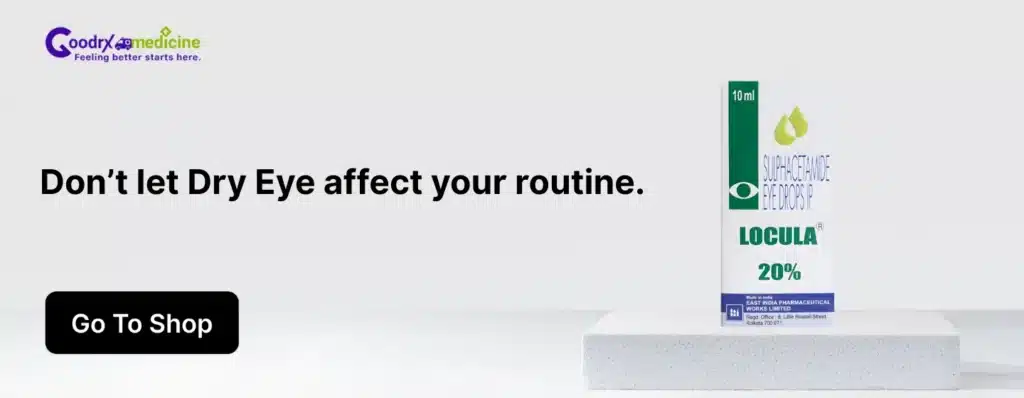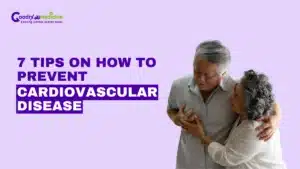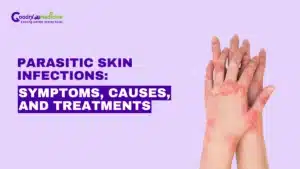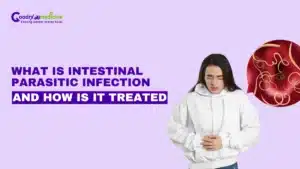Dry Eye is a chronic condition affecting millions worldwide. It occurs when the eyes do not produce sufficient tears or when the quality of the tears is inadequate to keep the eye’s surface adequately lubricated.
This can lead to eye discomfort, irritation, redness, and even vision problems. Several factors, such as aging, environmental factors, and a few medications, can all contribute to Dry Eye.
Understanding the causes, symptoms, and diagnosis of Dry Eye is essential for managing this condition and maintaining optimal eye health. This article discusses the various ways to treat Dry Eye, its symptoms, causes, and diagnosis.
Symptoms of Dry Eyes
Before learning about effective treatment, it is essential to understand what Dry Eye feels like. Some of the common symptoms of Dry Eye include:
- Dryness and gritty or sandy sensation
- Burning or stinging sensation in the eyes
- Itching and redness
- Excess tearing (reflex tearing)
- Pain and Photophobia (sensitivity to light) in severe cases
- Blurred vision
- Stringy discharge from the eyes
Symptoms often worsen in dry, windy, or air-conditioned environments and with prolonged visual tasks such as computer use.

Types and causes of Dry Eye
Dry Eye is broadly classified into the following main types:
- Aqueous Tear Deficiency (ATD): It is caused by insufficient tear production from the Lacrimal Glands. This type is common in older adults, postmenopausal women, and individuals with autoimmune diseases such as Sjögren’s Syndrome and Rheumatoid Arthritis.
- Evaporative Dry Eye (EDE): It is caused by excessive tear evaporation due to lipid layer deficiency, often from Meibomian Gland Dysfunction (MGD), Blepharitis, Rosacea, or eyelid abnormalities. Reduced blinking (e.g., during prolonged screen use) and environmental factors like low humidity also contribute to this type of Dry Eyes.
- Other factors: Several factors can also contribute to developing Dry Eye, such as long-term use of contact lenses and allergic eye diseases.
Diagnosis
Some common diagnoses involved in Dry Eyes are as follows:
- Detailed history focusing on symptoms and risk factors.
- Clinical examination with Slit-lamp Biomicroscopy to assess tear film, eyelids, Meibomian Glands, and ocular surface.
- Measure tear film stability with Tear Break-Up Time (TBUT) or Non-Invasive TBUT (NIBUT).
- Assess tear production using the Schirmer or Phenol Red Thread test.
- Check tear osmolarity with devices like TearLab.
- Test corneal sensitivity if neurosensory abnormalities are suspected.
- Detect ocular surface damage using Fluorescein or Lissamine green staining.
Dry Eyes treatment
There are several comfortable and effective ways to treat Dry Eyes and improve general eye health. The different methods usually depend on the severity of the condition. Now, let us discuss these common treatment methods for Dry Eyes in detail.
Artificial tear drops
Artificial tears are an effective way to ease the pain of Dry Eyes. These soothing eye solutions look and feel like natural tears and keep the eyes fresh.
They help reduce the itchiness, redness, and gritty feeling that often comes with Dry Eye Syndrome. Artificial tears provide instant relief by stabilizing the tear film and stopping it from evaporating too quickly.
Lacrimal Plugs
For people with Dry Eyes, Lacrimal Plugs, also called Punctal Plugs, can help. These tiny, biocompatible devices are placed into the tear ducts to reduce the flow of tears from the eye’s surface.
By keeping more natural tears in the eye, Lacrimal Plugs successfully increase the eye’s moisture and ease the symptoms of Dry Eyes. This process is minimally invasive and can be undone; also, it can be customized to keep your eyes comfortable.
People who have persistent Dry Eyes may find Lacrimal Plugs helpful since they help retain tears for a longer time in the eye. Consult a doctor for evaluation and placement of the Lacrimal Plugs.
Medicines
Cyclosporine (Restasis), an anti-inflammatory medicine, is the most often recommended medicine for Dry Eyes. This medicine helps improve tear production and significantly reduces the risk of corneal damage. Another medicine that is often given to treat Dry Eyes is Xiidra.
If you have very Dry Eyes, you may need to use Corticosteroid Eye Drops for a short while along with the main medicine. These medicines prevent the eye from permanently being damaged, which can happen with some eye problems. They also help with swelling, irritation, and other kinds of pain.
Other medicines, such as Cholinergic (Pilocarpine), can also help, though they are not as commonly prescribed. Furthermore, if your medications cause Dry Eye, your doctor may adjust its dosage to reduce the severity of the risk.
Surgery
A doctor may offer surgery as a solution for people with severe Dry Eye Syndrome that doesn’t improve with other treatments. This process permanently closes the tear drainage ducts in the inner corners of the eyes. This will make sure that your eyes retain enough tears.
Furthermore, your doctor can recommend intense-pulsed light therapy that helps if you have severe Dry Eyes. You can also use special contact lenses to help people with Dry Eyes.
Simple home remedies for Dry Eyes
Some home remedies for Dry Eyes include simple lifestyle changes and incorporating healthy habits. Some of the best home remedies to treat Dry Eyes include the following:
- Over-the-counter eye drops: Use over-the-counter lubricating eye drops (preferably preservative-free) to supplement natural tear production.
- Warm compress: Apply a warm compress to closed eyes for several minutes to help unclog oil glands and improve tear quality.
- Maintain eye hygiene: Clean eyelids and lashes with a gentle cleanser to remove dirt or debris from the eyes and open blocked glands.
- Humidifier: A humidifier adds moisture to your house’s air and prevents tear evaporation.
- Limit screen time: Limit screen time and take frequent breaks to rest your eyes and encourage blinking.
- Stay hydrated: Drink plenty of water and reduce consumption of dehydrating substances like alcohol.
- Protect your eyes outdoors: Wear sunglasses outdoors to protect your eyes from wind and sunlight, which can worsen dryness.
- Eat a healthy diet: Eat antioxidant-rich foods (like leafy greens, carrots, and citrus fruits) to support overall eye health. Furthermore, increase intake of omega-3 fatty acids (from fatty fish, flaxseeds, walnuts, or supplements) to reduce inflammation and improve tear quality.
- Seek medical help: Consult a doctor if symptoms persist or worsen to treat underlying conditions.
Conclusion
Effective Dry Eye treatment is essential to relieve the symptoms of Dry Eye, such as burning eye sensation and excessive tearing. Several reasons can contribute to the development of Dry Eye, including prolonged screen time and excessive or insufficient tear production.
Your doctor can diagnose the condition after reviewing your medical history and performing specific diagnostic tests. Your doctor can then prescribe several treatment choices, from natural to medical, to relieve the symptoms.
Artificial tears and Lacrimal Plugs offer immediate relief, while medications like Cyclosporine (Restasis) and Xiidra can significantly improve tear production. Surgery becomes an option for severe cases when other treatments prove ineffective.
Home remedies can also help treat Dry Eyes. Lifestyle modifications, such as protecting the eyes outdoors, drinking plenty of water, using over-the-counter eye drops, warm compresses, and basic eye hygiene, can also help manage Dry Eye symptoms.
Consulting an eye care professional before using Dry Eye treatment is essential to reducing the risks of side effects. Your doctor can prescribe the best treatment for improved relief and protect your eyes from further damage.
Frequently Asked Questions
Do Dry Eyes heal on their own?
Yes, if you eliminate an irritant that is bothering your eye, Dry Eye symptoms may disappear. Symptoms may also come and go as the seasons change. Making simple changes to your life can also help keep Dry Eye problems away. However, if you have a persistent Dry Eye, consult your doctor.
Is Dry Eye a serious problem?
No, Dry Eye is not a severe problem, and it is common in older people. However, leaving Dry Eye untreated can lead to eye inflammation, damage to the corneal surface, Corneal Ulcers, and vision loss due to Dry Eye in some cases. It is essential to consult your doctor and seek prescribed treatment.
Does vitamin deficiency cause Dry Eye?
Yes, Vitamin D deficiency can make your eyes feel dry. Vitamin D levels are much lower in people with Dry Eye. Thus, you can take prescribed Vitamin D pills to help the immune system work better, lower inflammation in the eyes, and make more tears to improve tear quality.
At what age does Dry Eye start?
People over 50 are more likely to have Dry Eyes. Older people are also likely to get Dry Eyes if they have an autoimmune disease like Diabetes, have had eye surgery in the past, or take different medicines. It is essential to consult your doctor and seek regular eye examinations.
When referencing outside resources, GoodrxMedicine always provides full citations. To learn more about the measures we use to maintain the quality of our content, please review our Content Information Policy.











